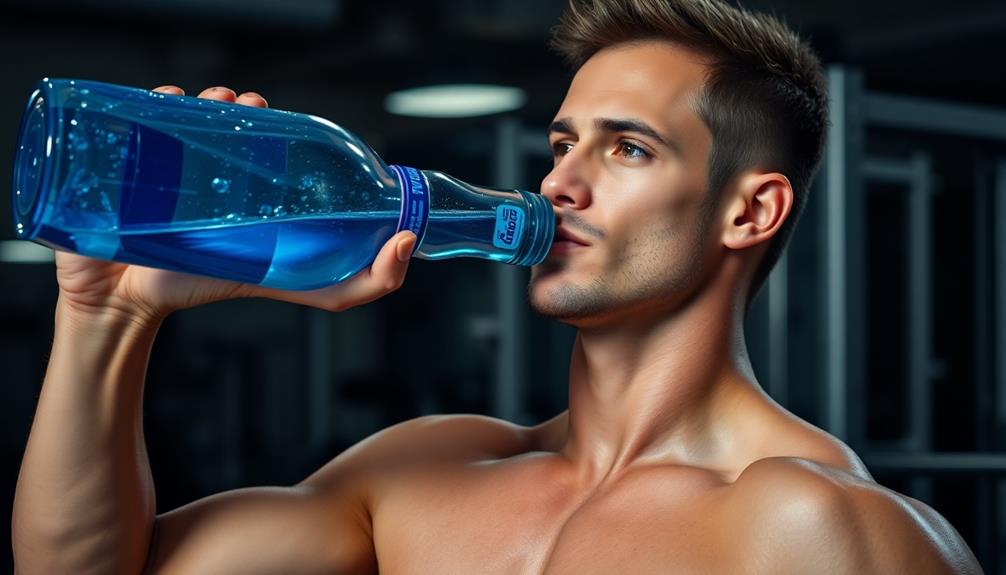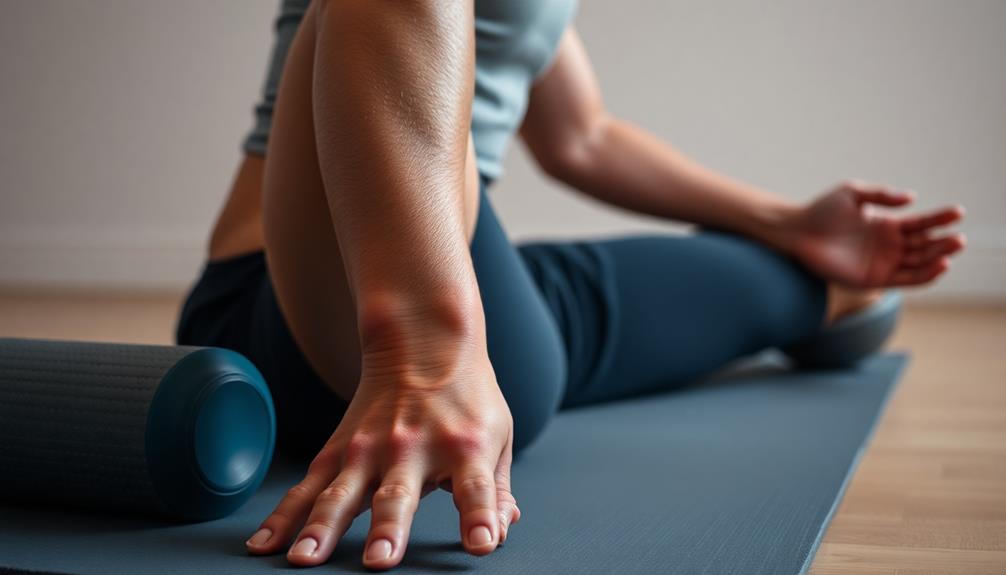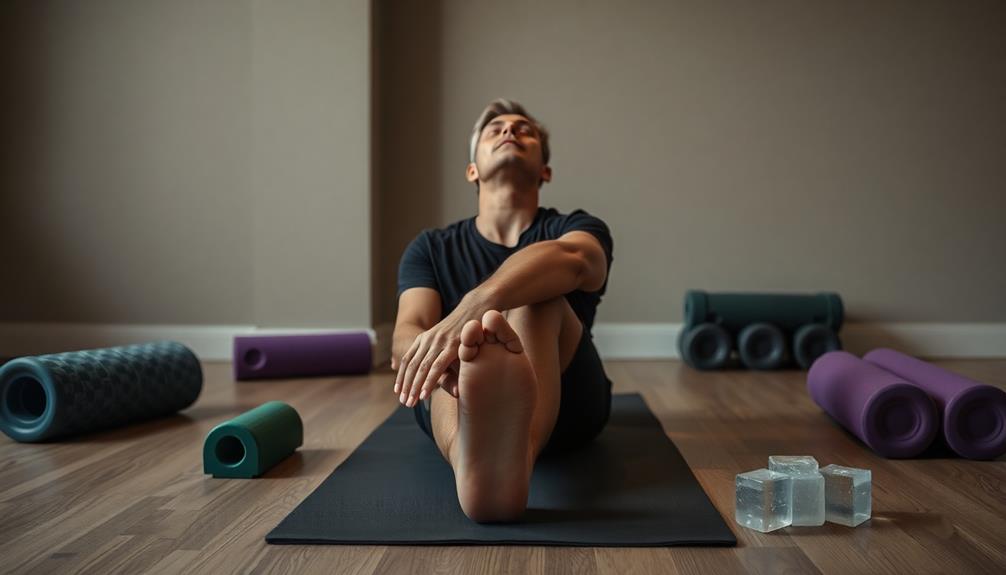To manage soreness after hypertrophy training, focus on proper nutrition and hydration. Consume protein and carbs post-workout, and drink plenty of water throughout the day. Implement active recovery techniques like light exercises and foam rolling. Prioritize sleep for muscle repair, and consider using compression garments. Incorporate gentle stretching and Epsom salt baths for muscle relaxation. Don't forget to warm up properly before workouts and maintain good form during exercises. Consider supplementation with BCAAs and omega-3s, but always consult a professional first. Keep a workout journal to track progress and adjust your training as needed. These strategies will help you optimize your recovery and training results.
Core Insight
- Consume a post-workout meal with protein and carbohydrates to support muscle recovery and reduce soreness.
- Implement active recovery techniques like light walking or swimming to promote blood flow and alleviate muscle stiffness.
- Use foam rolling and stretching exercises to target sore muscles and improve flexibility after hypertrophy training.
- Prioritize adequate sleep and hydration to support the body's natural recovery processes and minimize muscle soreness.
- Incorporate anti-inflammatory foods and consider supplements like BCAAs to aid in muscle repair and reduce post-workout pain.
Prioritize Post-Workout Nutrition

After a tough workout, eating the right foods is key for recovery and reducing soreness. Eat a meal with protein and carbs within an hour after exercising. This helps your muscles rebuild and restores your energy.
Protein is essential, so choose sources like chicken, fish, or plant-based options. Aim for 20-30 grams in your post-workout meal. Combine it with carbs like whole grains, sweet potatoes, or fruit.
Drinking enough water is also critical. It helps remove waste products that can make you sore. Consider adding foods that fight inflammation to your meal, such as berries, leafy greens, or fish with omega-3s. These may help ease muscle discomfort.
Implement Active Recovery Techniques

Light exercise after a workout can help your muscles recover faster. Here are some easy things you can do:
- Go for a 15-20 minute walk or bike ride at a relaxed pace
- Spend 10-15 minutes stretching the muscles you just worked out
- Use a foam roller for 5-10 minutes on sore spots
- Do a gentle yoga routine for 20-30 minutes
- Swim laps at an easy pace for 20-30 minutes
Start with a short cardio session to get your blood moving. Then, stretch out the muscles you used during your workout. A foam roller can help work out knots and tight areas. Yoga is great for improving flexibility and letting go of stress. Swimming is another good option that's easy on your body. Pay attention to how you feel and take breaks if needed. These simple techniques will help you bounce back from tough workouts.
Utilize Foam Rolling

Foam rolling is a great way to massage your own muscles and relieve soreness after a tough workout. It can help loosen tight muscles and increase blood flow to the areas that need it most. Firm foam rollers work best for getting deep into the muscle tissue and breaking up knots.
To foam roll, put the roller under the sore muscle and slowly move back and forth. Apply as much pressure as you can handle without causing pain. Spend about 30-60 seconds on each muscle, focusing on the tightest or most tender spots. The pressure helps break up tightness in the muscles and surrounding tissue, which reduces soreness and increases flexibility.
Try foam rolling after your workouts or on days when you're not training. It's a simple, low-cost way to help your muscles recover and stay healthy.
Stay Hydrated

Staying hydrated is key to reducing soreness after strength training. Drinking water helps remove waste and lessens swelling in your muscles. Drink water before, during, and after exercising to keep hydration at the right level. Try to drink at least 8-10 glasses of water daily, and drink more on days you work out.
Quick tips for staying hydrated:
| When | What to Do | Why It Helps |
|---|---|---|
| Before training | Drink 16-20 oz water | Gets muscles ready |
| While training | Take sips of water often | Keeps up performance |
| After training | Drink 16-20 oz water | Speeds up recovery |
| All day long | Steadily drink water | Improves overall health |
Get Adequate Sleep

Getting enough sleep is just as important as staying hydrated for managing muscle soreness after a workout. While you sleep, your body repairs and rebuilds muscle tissue, which helps you recover from intense training. Sleep also helps regulate hormones and metabolism, further improving recovery. Aim to get 7-9 hours of quality sleep each night to support your body's natural healing process.
To improve your sleep quality and maximize recovery:
- Go to bed and wake up at the same time every day
- Create a relaxing routine before bed, like reading or stretching
- Avoid using electronic devices and bright lights at least an hour before bed
Apply Cold and Heat Therapy

Cold and heat therapy are great for managing post-workout soreness. Right after your workout, use cold to reduce swelling and pain. You can ice the sore spots or take a cold shower for 10-15 minutes.
After a day or two, switch to heat. This boosts blood flow to help you heal. Try a heating pad or warm bath for 15-20 minutes.
You can also alternate cold and hot in the shower. Spend a minute or two on each temperature and repeat a few times. This gets your circulation going and loosens tight muscles.
Always put a thin towel between your skin and the ice pack. And never use heat on new injuries or areas that are inflamed.
Try Compression Garments

Compression garments can help with post-workout soreness. They boost blood flow and cut down on muscle jiggling. This may speed up recovery and lessen delayed muscle pain (DOMS). If you're new to compression clothes, here's what to look for:
- Fit: They should be snug but not too tight
- Material: Choose fabrics that pull sweat away from your skin to stay dry
- Targeted areas: Pick pieces that focus on the muscles you worked
You can wear them during exercise or after. Many athletes like wearing them for a few hours post-workout or overnight. Studies on how well they work are mixed. But lots of people say they have less soreness and recover faster with compression gear.
Incorporate Gentle Stretching

Gentle stretching is a great way to help with muscle soreness after a workout. Add some easy stretches to your cool-down routine to relax tense muscles and boost flexibility. Stretch the muscles you worked out, holding each stretch for 15-30 seconds. Don't bounce or push too hard. If you have really sore spots, try using reusable gel packs before or after stretching for extra relief.
Begin with simple, easy stretches that don't hurt. Slowly increase the intensity as your muscles loosen up. Stretching shouldn't be painful. You should feel a slight pull in the muscles you're targeting. Try deep breathing while you stretch to relax and get more blood flowing to sore areas. Stretch both the muscles you worked and the opposite muscle groups for even recovery. Regular, gentle stretching can ease soreness and help you move better between workouts.
Consider Supplementation

Certain supplements may help you recover from tough workouts. A balanced diet is key, but supplements can give extra support. Whey protein powders work well – they have 24-25g of protein per serving to help your muscles recover. You can also try:
- Omega-3s: These can reduce soreness and help you bounce back faster.
- BCAAs: They decrease muscle damage and speed up repair.
- Tart cherry juice: It's full of antioxidants that may ease muscle pain and swelling.
When picking supplements, talk to your doctor or a nutritionist. They'll help you choose the right ones for you and how to use them safely. Don't forget, supplements aren't a replacement for a good diet. They should be an addition to the healthy foods you eat to help you recover from intense training.
Listen to Your Body

Pay attention to how sore you are after a workout. It's normal to feel some soreness, but if you're in a lot of pain, it could mean you're injured. If it really hurts, make sure to rest so your body can recover. Don't take supplements that claim to detox you naturally – they don't help and could even be harmful.
When you work out again, be aware of how your muscles are feeling. If you're still really sore, think about resting longer or working different muscles. Don't exercise through extreme pain, because that's how you get injured or overtrain. Instead, try reducing how hard or how much you're exercising.
Everyone recovers differently, so what helps other people might not be right for you. Pay attention to what your body is telling you, and use that to decide how to train and recover.
Frequently Asked Questions
How Long Does Post-Workout Muscle Soreness Typically Last?
You'll typically experience post-workout muscle soreness for 24 to 72 hours. It's called Delayed Onset Muscle Soreness (DOMS). The duration can vary based on your fitness level, workout intensity, and recovery practices. Don't worry, it's normal!
Can Over-The-Counter Pain Medications Help With Muscle Soreness?
Yes, over-the-counter pain medications can help with muscle soreness. You'll find that NSAIDs like ibuprofen or naproxen can reduce inflammation and pain. However, don't rely on them too often, as they may interfere with muscle growth.
Is It Safe to Train the Same Muscle Group While Still Sore?
While it's generally safe to train sore muscles, you'll want to listen to your body. If you're experiencing severe pain, it's best to rest. Otherwise, you can work out, but consider reducing intensity or volume.
Does Age Affect Recovery Time From Muscle Soreness?
Yes, age does affect recovery time from muscle soreness. As you get older, you'll likely notice it takes longer for your muscles to bounce back. You'll need more rest between workouts to allow for proper recovery.
Can Certain Foods or Diets Reduce Muscle Soreness More Effectively?
Yes, certain foods can help reduce muscle soreness. You'll want to focus on anti-inflammatory foods like cherries, berries, and fatty fish. Also, increase your protein intake and stay hydrated to support muscle recovery and reduce discomfort.

